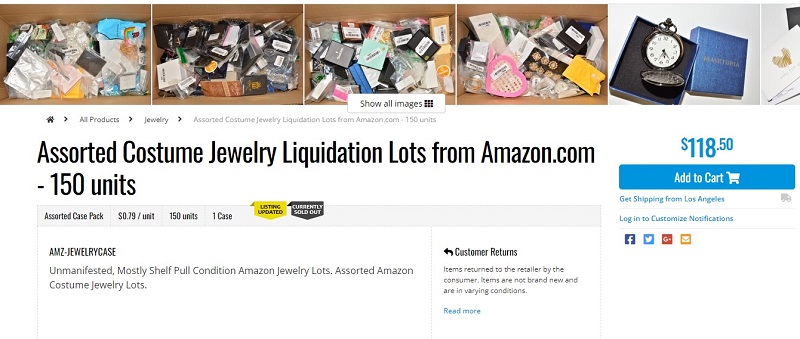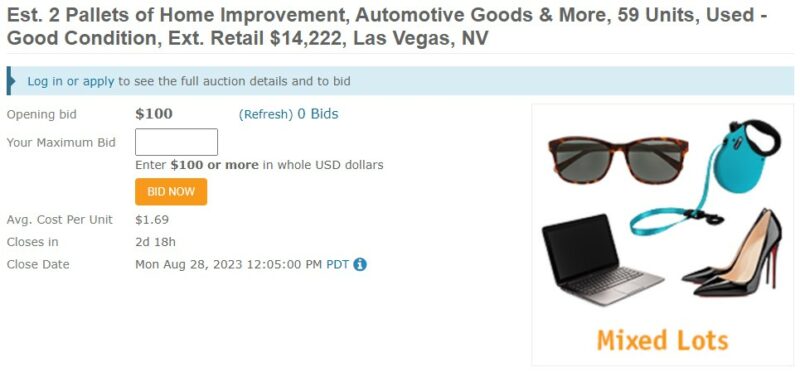When I went down the rabbit hole of researching how to buy unclaimed Amazon packages, there was another category of Amazon returns that caught my eye.
“Amazon return pallets.”
I have friends who talk about Amazon like it’s a rental service. Buy something, use it a little, then return it. I’m not a fan of the practice but if I know someone who openly talks about it, chances are you do to. A lot of people do this.
And so what happens to all these returned products? Maybe some of them “go back on the shelf” and can be re-sold. But the vast majority, especially smaller, low-dollar amount items, aren’t worth sorting through and selling as used or open box. They just stick it in a big box with other similar items and auction them off.
That “big box” isn’t typically a single box (though it could be, I suppose), it’s now packaged up with other boxes and loaded onto a plastic wrapped pallet – an Amazon return pallet.
Are these things worth buying? Should you invest in one, break it apart, and then try to sell them on eBay, Poshmark, Facebook Marketplace, Craigslist or somewhere else?
Table of Contents
Where to Buy an Amazon Return Pallet
First, where can you buy an Amazon return pallet?
There are three ways you can buy an Amazon return pallet:
- Buy them through Liquidation sites: Similar to what we discussed when we talked about buying unclaimed Amazon packages, the same sites also sell pallets of items. This will usually be an auction but sometimes you can find items listed as a fixed price. The sites to check out are BStock, Liquidation.com, DirectLiquidation.com, ViaTrading.com, and Quiklotz.
- Check out Facebook and look for local groups that advertise “pallet liquidation sales” – you can just put it in the search bar and Facebook will find them. There are a lot of groups, try to find those near you.
- Finally, you can check out Liquidation Map to look for marketplaces near you that might include the sale of pallets. These will be flea markets, wholesalers, etc.
Are Amazon Return Pallets Worth the Investment?
What is inside each pallet?
The reality is that it’s a crapshoot.
You can expect to find a random assortment of items inside an Amazon return pallet. There is no rhyme or reason, other than they fit inside the boxes, and it’s impossible to know what you could get before you open up the boxes.
Sometimes the pallets will follow themes but there’s never a guarantee that everything in the pallet follows that theme.
For example, this listing on ViaTrading.com suggests you have 150 units of costume jewelry:

The photos give you an idea of what might be inside but you only get shots of the top of a few boxes. There are also a few close up shots too, enough to decide whether it’s worth paying 80 cents a piece for them.
Here’s another listing from BStock:

As you can see, not much to go on other than an estimated retail value of $14,000. (I bet you learn more if you register for an account)
This is meant for resellers
If you’re thinking about buying a pallet to find some magical item, don’t. These are meant for folks who are looking for inexpensive inventory that they can re-sell elsewhere.
In the costume jewelry example above, you may want it because you’re going to re-sell them or you’re planning on throwing a birthday party and want to give a bunch of kids some cheap costume jewelry to play with.
Other pallets can help you jump start an ecommerce business by boosting your inventory. Sometimes, it’s just an enterprising individual willing to take the time to list items on Facebook Marketplace or Craigslist and flipping items they find inside the pallet (and they were lucky enough to find items worth selling).
Here’s a video from my friend Steve on how to flip Amazon return pallets for cash:
Beware pallets that have been “cherry picked”
There are some “enterprising” folks who buy pallets, pick through them for the best stuff, and then repackage them for sale as Amazon return pallets.
Never ever buy these! (unless it’s so incredibly cheap you know you can make money with it… even then…)
If an Amazon return pallet is a gamble to begin with, it’s a definite loser if someone else has already picked through it and taken out the best stuff for themselves!
This can happen if you buy from liquidators that aren’t well known or are private sellers on Craigslist or Facebook Marketplace. Just do your homework so you can avoid being burned.
Are Amazon return pallets worth it?
Sadly, there’s no way to know for sure. Since these pallets can have a variety of items, there’s no way to say for sure whether it’s worth it. Even harder to justify it given how much time it would take to sell the items.
If you look on Youtube, you can see a lot of videos of folks sharing the gems they find inside a pallet. I don’t know if they’re all legit or if they’re seeding their pallets with sexy items to get more views.
Here’s a fun video from The Bin Store, which gets a lot of pallets each week, and they show you what is inside them:
As you can see, the pallets are a ton of stuff! In one of their pallets, they found an Apple watch that was returned because the box was dented!
As a result, there’s no way to know if you can make money from these.
So, can you make money off Amazon return pallets? Yes, especially if you run an operation like The Bin Store and can afford to buy a lot of pallets and then sort them into groups that you can put on to your shelves.
If you’re a side hustler looking to make some extra cash, you probably want to focus on pallets that follow some kind of theme so it’s easy to list them on eBay or Facebook Marketplace.
In the end, it’s a bit of a gamble. 😁



